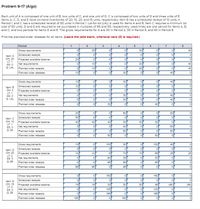
Concept explainers
Each unit of A is composed of one unit of B, two units of C, and one unit of D. C is composed of two units of D and three units of E. Items A, C, D, and E have on-hand inventories of 20, 10, 20, and 15 units, respectively. Item B has a

Trending nowThis is a popular solution!
Step by stepSolved in 2 steps with 2 images

- If the the Net Requirement for a product for a particular time period in a MRP problem is 101 and the organization uses an ordering policy of Lot-for-Lot, what would be the Planned Order Receipt?arrow_forwardA company produces skateboards. Each skateboard (A) consists of one unit of board (B), and two units of sub-assembly of roller-set (C). Roller-sets comprise of 2 components: 2 rollers (D) and one axle (E). The MPS is as follows: Week 1 2 3 4 5 6 7 8 9 10 A D 40 50 60 80 What are the planned order releases for item A? A has an on-hand inventory of 10, safety stock of 0. The lead time is 1 week and the ordering policy is Lot-for-Lot (L4L).arrow_forwardEach unit of A is composed of one unit of B, two units of C, and one unit of D. C is composed of two units of D and three units of E. Items A, C, D, and E have on-hand inventories of 20, 10, 20, and 10 units, respectively. Item B has a scheduled receipt of 10 units in Period 1, and C has a scheduled receipt of 50 units in Period 1. Lot-for-lot (L4L) lot sizing is used for Items A and B. Item C requires a minimum lot size of 50 units. D and E are required to be purchased in multiples of 100 and 50, respectively. Lead times are one period for Items A, B, and C, and two periods for Items D and E. The gross requirements for A are 30 in Period 2, 30 in Period 5, and 40 in Period 8. Find the planned-order releases for all itemsarrow_forward
- Evaluate the ethical considerations involved in inventory optimization, including its social and environmental implications.arrow_forwardS/O rule. Using the following information, determine an order processing sequence using the S/Opriority rule.OrderProcessingTimeRemaining(days)Due Date(days)Number ofOperationsRemainingA 20 30 2B 11 18 5C 10 6 2D 16 23 4arrow_forwardWhy is accurate inventory such an important issue at Wheeled Coach?arrow_forward
- Problem 21-16 (Algo) One unit of A is composed of two units of B and three units of C. Each B is composed of one unit of F. C is made of one unit of D, one unit of E, and two units of F. Items A, B, C, and D have 20, 50, 30, and 25 units of on-hand inventory. Items A, B, and C use lot-for-lot (L4L) as their lot-sizing technique, while D, E, and F require multiples of 50, 100, and 90, respectively, to be purchased. B has scheduled receipts of 20 units in Period 1. No other scheduled receipts exist. Lead times are one period for Items A, B, and D, and two periods for Items C, E, and F. Gross requirements for A are 20 units in Period 1, 10 units in Period 2, 55 units in Period 6, and 50 units in Period 8. Find the planned order releases for all items. (Leave no cells blank - be certain to enter "0" wherever required.)arrow_forwardItem X is a standard item stocked in a company's inventory of spare parts. Each year, the firm uses about 2,000 units of Item X, which costs Php 1,000 per unit. Storage costs, which include insurance and cost of capital, amount to 18 percent of item unit cost. Placing an order for more of Item X costs Php 400. The company operates 360 days per year and Item X is received 9 days after placement of order.arrow_forwardOne unit of A is made of one unit of B and one unit of C. B is made of four units of C and one unit each of E and F. C is made of two units of D and one unit of E. E is made of three units of F. Item C has a lead time of one week; Items A, B, E, and F have two-week lead times; and Item D has a lead time of three weeks. Lot-for-lot (L4L) lot sizing is used for Items A, D, and E; lots of size 50, 100, and 50 are used for Items B, C, and F, respectively. Items A, C, D, and E have on-hand (beginning) inventories of 15, 55, 100, and 10, respectively; all other items have zero beginning inventory. We are scheduled to receive 10 units of A in Week 1, 100 units of C in Week 1, and 100 units of D in Week 3; there are no other scheduled receipts.If 50 units of A are required in week 10, use the low-level-coded bill-of-materials (product structure tree) to find the necessary planned-order releases for all components. (Leave the cells blank, whenever zero (0) is required.)arrow_forward
 Practical Management ScienceOperations ManagementISBN:9781337406659Author:WINSTON, Wayne L.Publisher:Cengage,
Practical Management ScienceOperations ManagementISBN:9781337406659Author:WINSTON, Wayne L.Publisher:Cengage, Operations ManagementOperations ManagementISBN:9781259667473Author:William J StevensonPublisher:McGraw-Hill Education
Operations ManagementOperations ManagementISBN:9781259667473Author:William J StevensonPublisher:McGraw-Hill Education Operations and Supply Chain Management (Mcgraw-hi...Operations ManagementISBN:9781259666100Author:F. Robert Jacobs, Richard B ChasePublisher:McGraw-Hill Education
Operations and Supply Chain Management (Mcgraw-hi...Operations ManagementISBN:9781259666100Author:F. Robert Jacobs, Richard B ChasePublisher:McGraw-Hill Education
 Purchasing and Supply Chain ManagementOperations ManagementISBN:9781285869681Author:Robert M. Monczka, Robert B. Handfield, Larry C. Giunipero, James L. PattersonPublisher:Cengage Learning
Purchasing and Supply Chain ManagementOperations ManagementISBN:9781285869681Author:Robert M. Monczka, Robert B. Handfield, Larry C. Giunipero, James L. PattersonPublisher:Cengage Learning Production and Operations Analysis, Seventh Editi...Operations ManagementISBN:9781478623069Author:Steven Nahmias, Tava Lennon OlsenPublisher:Waveland Press, Inc.
Production and Operations Analysis, Seventh Editi...Operations ManagementISBN:9781478623069Author:Steven Nahmias, Tava Lennon OlsenPublisher:Waveland Press, Inc.





